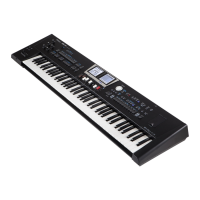Editing Individual Rhythm Events (Micro Edit)
117
Right Display
Right Display
7. Rotate the dial to set the value.
8. Push the dial to select the next value and edit it if
necessary.
9. When you’re done, press the [EXIT] button to return to
the Rhythm Composer pages, then save your rhythm. See
“Saving your Rhythm” (p. 106).
Event
type
Explanation
Note
velocity
and gate
time
messages
These messages always come in pairs. The rst value
(“42:F#2”, for example) refers to the note itself and the
second (“72”) to the velocity (playing dynamics).
The “Micro Edit” page adds a third message to that pair. It
describes the duration of the note in question. You may
remember this value from the “Track Edit” environment,
where it is called “Gate Time”.
The range for note numbers is “0 (C–)”~“127 (G9)”.
Velocity messages can be set anywhere between “1”
(extremely soft) and “127”. The value “0” cannot be entered,
because it would eectively switch o the note
NOTE
CC64 (Hold) events generated by a pedal switch
connected to the PEDAL HOLD jack are converted into
the equivalent GATE TIME values at the time of recording.
You may therefore have to change the duration of the
notes themselves.
CC
These messages usually add something to the notes being
played, like modulation, a dierent volume, a new stereo
position… The BK-9 recognizes (and allows you to edit) all
control change numbers the Rhythm uses (CC01, 10, 11, 91,
93) and displays their “ocial” name.
These messages can be set to the desired value (0~127)
when the corresponding eect is needed – but they also
need to be reset to “0” to avoid unpleasant surprises
PC/
Program
Change
These messages are used to select sounds within the
current bank. As there are only 128 possibilities, these
messages are usually preceded by control changes CC00
and CC32. That’s why the BK-9 inserts all three when you
use the “Create Event” function. To assign a Drum Set to
an Acc1~6 track, you must create a “CC00” event with the
value “111”.
NOTE
The CC00 value of ADrums tracks cannot be edited.
Pitch Bend
These messages are used for temporary changes to
the pitch of the notes being played at that time. Pitch
Bend messages can be positive or negative (the range is
–128~128). The value “0” means that the pitch of notes
being played in that area is not altered.
If a Pitch Bend occurrence is not reset to “0” at some stage,
all notes will keep sounding at when you no longer want
them to.
Event
type
Explanation
Alteration
Mode
This message type is only available for melodic rhythm
tracks (i.e. not for ADrums or ABass tracks) and needs to be
inserted by hand (using “Create Event”). Rhythm tracks you
only just recorded do not contain it.
It allows you to use a revolutionary system for adapting the
recorded notes to a more natural behavior (also known as
“voicing”). There are two options:
• Degree
This setting refers to the “old” system for real-time
conversion of rhythm track information for Rhythm
playback. Based on the fundamentals of the chords you
play during Arranger playback, it often leads to odd
jumps of certain parts.
• Nearest
Refers to a more musical system for real-time shifts of the
recorded rhythm notes during Rhythm playback.
Let us rst look at an illustration:
Recorded strings track Result with “Degree”
Result with “Nearest”
Chords played in the
recognition area.
This new system is called “Adaptive Chord Voicing”.
The notes of the melodic rhythm tracks are compared
against the chords played in the recognition area. If the
next chord you play contains the note the selected part is
already sounding (based on the previous chord), that note
is maintained.
If the new chord does not contain that note, the rhythm
part in question uses the closest (“Nearest”) note. In the
example above, the “G” is closer to the “A” sounded by the
strings part than the “C”. This produces a more musical
behavior than any other system on the market.
Both “Degree” and “Nearest” allow you to specify the note
range (“Limit Low” and “Limit High”) the selected part
may play. Notes that would fall outside that range during
Arranger playback are automatically transposed to values
inside the selected range.
Rather than specifying two note values, you can also
choose “Std”, which means that the BK-9 decides automati-
cally when extremely high (or low) notes need to be shifted
down (or up) by one or several octaves.

